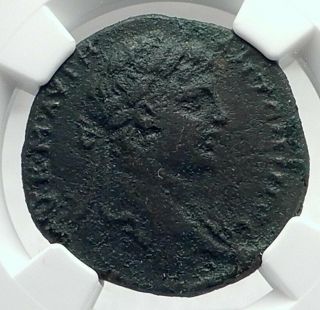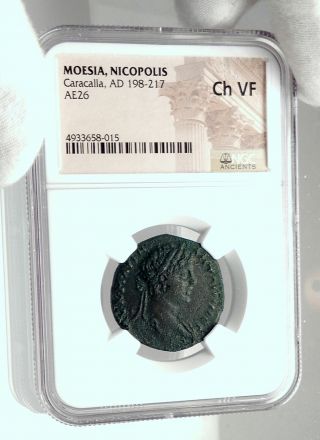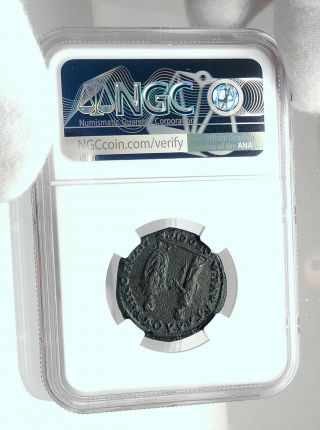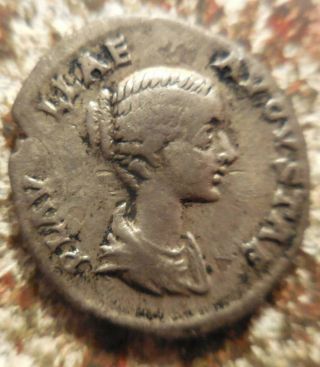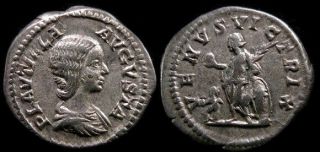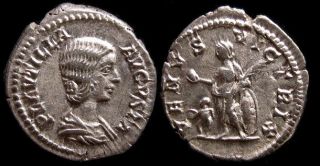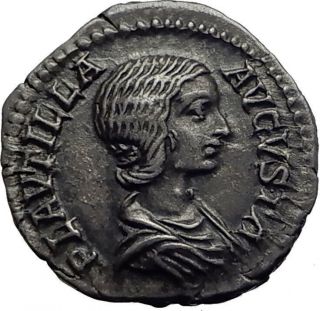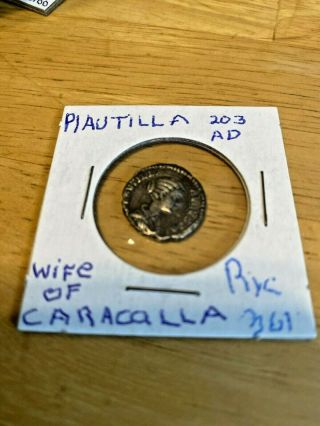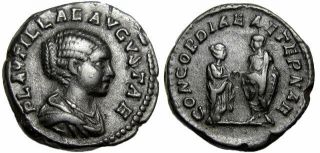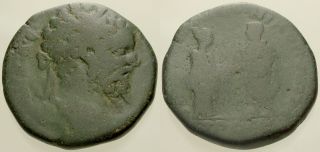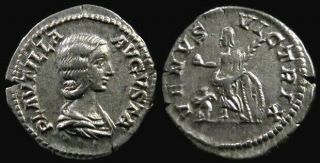CARACALLA & PLAUTILLA Roman Marriage Ancient Nicopolis Roman Coin NGC I77352
Item History & Price
| Reference Number: Avaluer:384925 | Certification Number: 4933658-015 |
| Grade: Ch VF | Certification: NGC |
Item: i77352
Authentic Ancient Coin of:Caracalla - Roman Emperor: 198-217 A.D.
Caracalla and Plautilla Marriage Ceremony
Bronze 26mm of Nicopolis ad Istrum in Moesia Inferior
under Magistrate Aurelius Gallus circa 198-209 A.D.
Certification: NGC Ancients Ch VF 4933658-015
AV K M AVP ANTΩNINOC, Laureate bust right with slight drapery over far left shoulder.
VΠ AVP ΓAΛΛOV NIKOΠOΛ ΠPOC IC, Caracalla and Plautilla clasping hands in marriage ceremony....You are bidding on the exact item pictured, provided with a Certificate of Authenticity and Lifetime Guarantee of Authenticity. Nicopolis ad Istrum was a Roman and Early Byzantine town founded by Emperor Trajan around 101-106, at the junction of the Iatrus (Yantra) and the Rositsa rivers, in memory of his victory over the Dacians. Its ruins are located at the village of Nikyup, 20 km north of Veliko Tarnovo in northern Bulgaria. The town reached its apogee during the reigns of Trajan, Hadrian, the Antonines and the Severan dynasty.The classical town was planned according to the orthogonal system. The network of streets, the forum surrounded by an Ionic colonnade and many buildings, a two-nave room later turned into a basilica and other public buildings have been uncovered. The rich architectures and sculptures show a similarity with those of the ancient towns in Asia Minor. Nicopolis ad Istrum had issued coins, bearing images of its own public buildings.In 447 AD, the town was destroyed by Attila's Huns. Perhaps it was already abandoned before the early 400s. In the 6th century, it was rebuilt as a powerful fortress enclosing little more than military buildings and churches, following a very common trend for the cities of that century in the Danube area.The largest area of the extensive ruins (21.55 hectares) of the classical Nicopolis was not reoccupied since the fort covered only one fourth of it (5.75 hectares), in the southeastern corner. The town became an episcopal centre during the early Byzantine period. It was finally destroyed by the Avar invasions at the end of the 6th century. A Bulgarian medieval settlement arose upon its ruins later (10th-14th century).Nicopolis ad Istrum can be said to have been the birthplace of Germanic literary tradition. In the 4th century, the Gothic bishop, missionary and translator Ulfilas (Wulfila) obtained permission from Emperor Constantius II to immigrate with his flock of converts to Moesia and settle near Nicopolis ad Istrum in 347-8. There, he invented the Gothic alphabet and translated the Bible from Greek to Gothic.Marriage in ancient Rome was a strictly monogamous institution: a Roman citizen by law could have only one spouse at a time. The practice of monogamy distinguished the Greeks and Romans from other ancient civilizations, in which elite males typically had multiple wives. Greco-Roman monogamy may have arisen from the egalitarianism of the democratic and republican political systems of the city-states. It is one aspect of ancient Roman culture that was embraced by early Christianity, which in turn perpetuated it as an ideal in later Western culture.Marriage had mythical precedents, starting with the abduction of the Sabine Women, which may reflect the archaic custom of bride abduction. Romulus and his band of male immigrants were rejected conubium, the legal right to intermarriage, from the Sabines. According to Livy, Romulus and his men abducted the Sabine maidens, but promised them an honorable marriage, in which they would enjoy the benefits of property, citizenship, and children. These three benefits seem to define the purpose of marriage in ancient Rome.The word matrimonium, the root for the English word "matrimony, " defines the institution's main function. Involving the mater (mother), it carries with it the implication of the man taking a woman in marriage to have children. It is the idea conventionally shared by Romans as to the purpose of marriage, which would be to produce legitimate children; citizens producing new citizens.Consortium is a word used for the sharing of property, usually used in a technical sense for the property held by heirs, but could also be used in the context of marriage. Such usage was commonly seen in Christian writings. However, the sharing of water and fire (aquae et ignis communiciatio) was symbolically more important. It refers to the sharing of natural resources. Worldly possessions transferred automatically from the wife to the husband in archaic times, whereas the classical marriage kept the wife's property separate.In order for the union of a man and woman to be legitimate, there needed to be consent legally and morally. Both parties had to be willing and intend to marry, and both needed their fathers' consent. If all other legal conditions were met, a marriage was made. Roman couple joining hands; the bride's belt may show the knot symbolizing that the husband was "belted and bound" to her, which he was to untie in their bedPlautilla - Augusta - 202-205 A.D.Wife of Caracalla | Sister-in-law of Geta
Daughter-in-law of Septimus Severus and Julia DomnaPublia Fulvia Plautilla, Fulvia Plautilla or Plautilla (c. 185/around 188/189 - early 212) was the only wife of the Roman emperor Caracalla, who was her paternal second cousin. After her father was condemned for treason, she was exiled and eventually killed on Caracalla's orders.
Caracalla 198-217 A.D.Caesar: 195-198 A.D. (under Septimius Severus)
Augustus: 198-217 A.D. (198-209 A.D. with Septimius Severus) (209-211 A.D. with Septimius Severus and Geta) (211 A.D. with Geta) (211-217 A.D. Sole Reign)
Son of Septimius Severus and Julia Domna | Brother of Geta | Husband of Plautilla | Nephew of Julia Maesa | Cousin of Julia Soaemias and Julia Mamaea |Caracalla (4 April 188 - 8 April 217), formally Marcus Aurelius Severus Antoninus Augustus, was Roman emperor from AD 198 to 217. A member of the Severan Dynasty, he was the eldest son of Septimius Severus and Julia Domna. Caracalla reigned jointly with his father from 198 until Severus' death in 211. Caracalla then ruled jointly with his younger brother Geta, with whom he had a fraught relationship, until he had Geta murdered later that year. Caracalla's reign was marked by domestic instability and external invasions from the Germanic people.Caracalla's reign was notable for the Antonine Constitution (Latin: Constitutio Antoniniana), also known as the Edict of Caracalla, which granted Roman citizenship to nearly all freemen throughout the Roman Empire. The edict gave all the enfranchised men Caracalla's adopted praenomen and nomen: "Marcus Aurelius". Domestically, Caracalla was known for the construction of the Baths of Caracalla, which became the second-largest baths in Rome, for the introduction of a new Roman currency named the antoninianus, a sort of double denarius, and for the massacres he enacted against the people of Rome and elsewhere in the empire. Towards the end of his rule, Caracalla began a campaign against the Parthian Empire. He did not see this campaign through to completion due to his assassination by a disaffected soldier in 217. He was succeeded as emperor by Macrinus after three days.Caracalla is presented in ancient sources as a tyrant and cruel leader, an image that has survived into modernity. Dio Cassius and Herodian present Caracalla as a soldier first and emperor second. In the 12th century, Geoffrey of Monmouth started the legend of Caracalla's role as the king of Britain. Later, in the 18th century, Caracalla's memory was revived in the works of French artists due to the parallels between Caracalla's apparent tyranny and that of King Louis XVI. Modern works continue to portray Caracalla as a psychopathic and evil ruler. His rule is remembered as being one of the most tyrannical of all Roman emperors.NamesCaracalla was born Lucius Septimius Bassianus. He was renamed Marcus Aurelius Antoninus at the age of seven as part of his father's attempt at union with the families of Antoninus Pius and Marcus Aurelius. According to Aurelius Victor in his Epitome de Caesaribus, he became known by the agnomen "Caracalla" after a Gallic hooded tunic that he habitually wore and made fashionable. He may have begun wearing it during his campaigns on the Rhine and Danube. Dio generally referred to him as Tarautas, after a famously diminutive and violent gladiator of the time.LifeEarly lifeCaracalla was born in Lugdunum, Gaul (now Lyon, France), on 4 April 188 to Septimius Severus and Julia Domna. He had a slightly younger brother, Geta, who would briefly rule as co-emperor alongside him. Caracalla's father, Septimius Severus, appointed Caracalla joint Augustus and full emperor from the year 198 onwards. His brother Geta was granted the same title in 210. In 202 Caracalla was forced to marry the daughter of Gaius Fulvius Plautianus, Fulvia Plautilla, a woman whom he hated, though for what reason is unknown. By 205 Caracalla had succeeded in having Plautianus executed for treason, though he had probably fabricated the evidence of the plot himself. It was then that he banished his wife, whose later killing might have been carried out under Caracalla's orders.ReignBrother's Murder Caracalla's father, Septimius Severus, died on 4 February 211 at Eboracum (now York) while on campaign in Caledonia, north of the Roman Britannia. Caracalla and his brother, Publius Septimius Antoninus Geta, jointly inherited the throne upon their father's death. Caracalla and Geta ended the campaign in Caledonia after concluding a peace with the Caledonians that returned the border of Roman Britain to the line demarcated by Hadrian's Wall. During the journey back to Rome with their father's ashes, Caracalla and his brother continuously argued with one another, making relations between them increasingly hostile. Caracalla and Geta considered dividing the empire in half along the Bosphorus to make their co-rule less hostile. Caracalla was to rule in the west and Geta was to rule in the east. They were persuaded not to do this by their mother.On 26 December 211, at a reconciliation meeting arranged by their mother, Caracalla had Geta assassinated by members of the Praetorian Guard loyal to himself, Geta dying in his mother's arms. Caracalla then persecuted and executed most of Geta's supporters and ordered a damnatio memoriae pronounced by the Senate against his brother's memory. Geta's image was removed from all paintings, coins were melted down, statues were destroyed, his name was struck from papyrus records, and it became a capital offence to speak or write Geta's name. In the aftermath of the damnatio memoriae, an estimated 20, 000 people were massacred. Those killed were Geta's inner circle of guards and advisers, friends, and other military staff under his employ.Provincial tours The Roman Empire during the reign of Caracalla In 213, about a year after Geta's death, Caracalla left Rome never to return. He went north to the German frontier to deal with the Alamanni and Goths tribesmen, a confederation of migrating Germanic tribes who had broken through the limes in Raetia. During the campaign of 213-214, Caracalla successfully defeated some of the Germanic tribes while settling other difficulties through diplomacy, though precisely with whom these treaties were made remains unknown. While there, Caracalla strengthened the frontier fortifications of Raetia and Germania Superior, collectively known as the Agri Decumates, so that it was able to withstand any further barbarian invasions for another twenty years. Historian Edward Gibbon compares Caracalla to emperors such as Hadrian who spent their careers campaigning in the provinces and then to tyrants such as Nero and Domitian whose entire reigns were confined to Rome and whose actions only impacted upon the senatorial and equestrian classes residing there. Gibbon then concludes that Caracalla was "the common enemy of mankind", as both Romans and provincials alike were subject to "his rapine and cruelty".After Caracalla concluded his campaign against the Alamanni, it became evident that he was inordinately preoccupied with the Greek-Macedonian general and conqueror Alexander the Great. He began openly mimicking Alexander in his personal style. In planning his invasion of the Parthian Empire, Caracalla decided to equip 16, 000 of his men with Macedonian-style phalanxes, despite the Roman army having made the phalanx an obsolete tactical formation. The historian Christopher Matthew mentions that the term Phalangarii has two possible meanings, both with military connotations. The first refers merely to the Roman battle line and does not specifically mean that the men were armed with pikes, and the second bears similarity to the 'Marian Mules' of the late Roman Republic who carried their equipment suspended from a long pole, which were in use until at least the 2nd century AD. As a consequence, the Phalangarii of Legio II Parthica may not have been pikemen, but rather standard battle line troops or possibly Triarii. Caracalla's mania for Alexander went so far that Caracalla visited Alexandria while preparing for his Persian invasion and persecuted philosophers of the Aristotelian school based on a legend that Aristotle had poisoned Alexander. This was a sign of Caracalla's increasingly erratic behaviour. But this mania for Alexander, strange as it was, was overshadowed by subsequent events in Alexandria.When the inhabitants of Alexandria heard of Caracalla's claims that he had killed his brother Geta in self-defence, they produced a satire mocking this as well as Caracalla's other pretensions. In 215 Caracalla travelled to Alexandria and responded to this insult by slaughtering the deputation of leading citizens who had unsuspectingly assembled before the city to greet his arrival, before setting his troops against Alexandria for several days of looting and plunder. Following the massacre at Alexandria, Caracalla moved east onto Armenia. By 216 he had pushed through Armenia and south into Parthia.Julia Domna During the reign of Septimius Severus, Julia Domna had played a prominent public role, receiving titles of honor such as "Mother of the camp", but she also played a role behind the scenes helping Septimius administer the empire. Described as ambitious, Julia Domna surrounded herself with thinkers and writers from all over the empire. While Caracalla was mustering and training troops for his planned Persian invasion, Julia remained in Rome, administering the empire. Julia's growing influence in state affairs was the beginning of a trend of emperors' mothers having influence, which continued throughout the Severan dynasty.When Geta died in 211, her responsibilities increased because Caracalla found administrative tasks to be mundane. She may have taken upon one of the more important civil functions of the emperor; receiving petitions and answering correspondence. The extent of her role in this position, however, is probably overstated. She may have represented her son and played a role in meetings and answering queries; however, the final authority on legal matters was Caracalla. When Caracalla was murdered, Julia was in Antioch sorting out correspondence, removing unimportant messages from the bunch so that when Caracalla returned, he would not be overburdened with duties. The emperor filled all of the roles in the legal system as judge, legislator, and administrator.Army policy During his reign as emperor, Caracalla raised the annual pay of an average legionary from 2000 sesterces (500 denarii) to 2700-3000 sesterces (675-750 denarii). He lavished many benefits on the army, which he both feared and admired, in accordance with the advice given by his father on his deathbed always to heed the welfare of the soldiers and ignore everyone else. Caracalla needed to gain and keep the trust of the military, and he did so with generous pay raises and popular gestures. He spent much of his time with the soldiers, so much so that he began to imitate their dress and adopt their manners.Baths
The Baths of Caracalla Construction on the Baths of Caracalla began in 211 at the start of Caracalla's rule. The baths are named for Caracalla, though it is most probable that his father was responsible for their planning. In 216 a partial inauguration of the baths took place, but the outer perimeter of the baths was not completed until the reign of Severus Alexander. These large baths were typical of the Roman practice of building complexes for social and state activities in large densely populated cities. The baths covered around 50 acres (or 202, 000 square meters) of land and could accommodate around 1, 600 bathers at any one time. They were the second largest public baths built in ancient Rome and were complete with swimming pools, exercise yards, a stadium, steam rooms, libraries, meeting rooms, fountains, and other amenities, all of which were enclosed within formal gardens. The interior spaces were decorated with colourful marble floors, columns, mosaics, and colossal statuary.Caracalla and Serapis At the outset of his reign, Caracalla declared divine support for Egyptian deity Serapis - a god of healing. The Iseum et Serapeum in Alexandria was apparently renovated during Caracalla's co-rule with his father Septimius Severus. The evidence for this exists in two inscriptions found near the temple that appear to bear their names. Additional archaeological evidence exists for this in the form of two papyrii that have been dated to the Severan period and also two statues associated with the temple that have been dated to around 200 AD. Upon Caracalla's ascension to sole ruler in 212, the imperial mint began striking coins bearing Serapis' image. This was a reflection of the god's central role during Caracalla's reign. After Geta's death, the weapon that had killed him was dedicated to Serapis by Caracalla. This was most likely done to cast Serapis into the role of Caracalla's protector from treachery.Caracalla also erected a temple on the Quirinal Hill in 212, which he dedicated to Serapis. A fragmented inscription found in the church of Sant' Agata dei Goti in Rome records the construction, or possibly restoration, of a temple dedicated to the god Serapis. The inscription bears the name "Marcus Aurelius Antoninus", a reference to either Caracalla or Elagabalus, but more likely to Caracalla due to his known strong association with the god. Two other inscriptions dedicated to Serapis, as well as a granite crocodile similar to one discovered at the Iseum et Serapeum, were also found in the area around the Quirinal Hill.Constitutio AntoninianaThe Constitutio Antoniniana (lit. "Constitution of Antoninus", also called "Edict of Caracalla" or "Antonine Constitution") was an edict issued in 212 by Caracalla declaring that all free men in the Roman Empire were to be given full Roman citizenship, with the exception of the dediticii, people who had become subject to Rome through surrender in war, and certain freed slaves. Whether the dediticii were excepted from the decree is a matter of debate.Before 212 the majority of Roman citizens had been inhabitants of Roman Italia, with about 4-7% of all peoples in the Roman empire being Roman citizens at the time of the death of Augustus in 14 AD. Outside Rome, citizenship was restricted to Roman coloniae - Romans, or their descendants, living in the provinces, the inhabitants of various cities throughout the Empire - and small numbers of local nobles such as kings of client countries. Provincials, on the other hand, were usually non-citizens, although some Magistrates and their families and relatives held the Latin Right.Dio maintains that one purpose for Caracalla issuing the edict was the desire to increase state revenue; at the time, Rome was in a difficult financial situation and needed to pay for the new pay raises and benefits that were being conferred on the military. The edict widened the obligation for public service and gave increased revenue through the inheritance and emancipation taxes that only had to be paid by Roman citizens. The provincials also benefited from this edict because they were now able to think of themselves as equal partners to the Romans in the empire. However, few of those that gained citizenship were wealthy, and while it is true that Rome was in a difficult financial situation, it is thought that this could not have been the sole purpose of the edict.Another purpose for issuing the edict, as described within the papyrus upon which part of the edict was inscribed, was to appease the gods who had delivered Caracalla from conspiracy. The conspiracy in question was in response to Caracalla's murder of Geta and the subsequent slaughter of his followers; fratricide would only have been condoned if his brother had been a tyrant. The damnatio memoriae against Geta and the large payments Caracalla had made to his own supporters were designed to protect himself from possible repercussions. After this had succeeded, Caracalla felt the need to repay the gods of Rome by returning the favour to the people of Rome through a similarly grand gesture. This was done through the granting of citizenship.Another purpose for issuing the edict might have been related to the fact that the periphery of the empire was now becoming central to its existence, and the granting of citizenship may have been simply a logical outcome of Rome's continued expansion of citizenship rights.Monetary policy The expenditures that Caracalla made with the large bonuses he gave to soldiers prompted him to debase the coinage soon after his ascension. At the end of Severus' reign, and early into Caracalla's, the Roman denarius had an approximate silver purity of around 55%, but by the end of his reign the purity had been reduced to about 51%.In 215 Caracalla introduced the antoninianus, a coin intended to serve as a double denarius. This new currency, however, had a silver purity of about 52% for the period between 215 and 217 and an actual size ratio of 1 antoninianus to 1.5 denarii. This in effect made the antoninianus equal to about 1.5 denarii. The reduced silver purity of the coins caused people to hoard the old coins that had higher silver content, making the inflation problem caused by the earlier devaluation of the denarii worse than it had been before.Parthian war In 216 Caracalla pursued a series of aggressive campaigns in the east against the Parthians, intended to bring more territory under direct Roman control. He offered the king of Parthia, Artabanus V of Parthia, a marriage proposal between himself and the king's daughter. Artabanus refused the offer, realizing that the proposal was merely an attempt to unite the kingdom of Parthia under the control of Rome. In response, Caracalla used the opportunity to start a campaign against the Parthians. That summer Caracalla began to attack the countryside east of the Tigris in the Parthian war of Caracalla. In the following winter, Caracalla retired to Edessa, modern Şanlıurfa in south-east Turkey, and began making preparations to renew the campaign by spring.DeathAt the beginning of 217, Caracalla was at Edessa with a large army preparing to start a new invasion of Parthia. On 8 April 217 Caracalla was travelling to visit a temple near Carrhae, now Harran in southern Turkey, where in 53 BC the Romans had suffered a defeat at the hands of the Parthians. After stopping briefly to urinate, Caracalla was approached by a soldier, Justin Martialis, and stabbed to death. Martialis had been incensed by Caracalla's refusal to grant him the position of centurion, and the Praetorian Guard Prefect Macrinus, Caracalla's successor, saw the opportunity to use Martialis to end Caracalla's reign. In the immediate aftermath of Caracalla's death, his murderer, Martialis, was killed as well. Three days later, Macrinus declared himself emperor with the support of the Roman army.Frequently Asked Questions
Mr. Ilya Zlobin, world-renowned expert numismatist, enthusiast, author and dealer in authentic ancient Greek, ancient Roman, ancient Byzantine, world coins & more.Who am I dealing with?You are dealing with Ilya Zlobin, ancient coin expert, enthusiast, author and dealer with an online store having a selection of over 15, 000 items with great positive feedback from verified buyers and over 10 years experience dealing with over 57, 000 ancient and world coins and artifacts. Ilya Zlobin is an independent individual who has a passion for coin collecting, research and understanding the importance of the historical context and significance all coins and objects represent. Most others are only concerned with selling you, Ilya Zlobin is most interested in educating you on the subject, and providing the largest selection, most professional presentation and service for the best long-term value for collectors worldwide creating returning patrons sharing in the passion of ancient and world coin collecting for a lifetime. How long until my order is shipped?Orders are shipped by the next business day (after receipt of payment) most of the time. How will I know when the order was shipped?After your order has shipped, you will be left positive feedback, and that date could be used as a basis of estimating an arrival date. Any tracking number would be found under your 'Purchase history' tab.USPS First Class mail takes about 3-5 business days to arrive in the U.S. International shipping times cannot be estimated as they vary from country to country.Standard international mail to many countries does not include a tracking number, and can also be slow sometimes. For a tracking number and signature confirmation, you may want to do Express Mail International Shipping, which costs more, however, is the fastest and most secure. Additionally you may be able to receive your order in as little as 3-5 business days using this method. For Express Mail International, it may be possible to place up to 10-15 items in one package (for the one shipping cost) as it is flat rate envelope, which may be the most cost-effective, secure and fastest way to receive items internationally. Send me a message about this and I can update your invoice should you want this method.Getting your order to you, quickly and securely is a top priority and is taken seriously here. Great care is taken in packaging and mailing every item securely and quickly.Please be aware, I cannot take responsibility for any postal service delivery delays, especially for international packages as it may happen in rare instances.What is a certificate of authenticity and what guarantees do you give that the item is authentic?Each of the items sold here, is provided with a Certificate of Authenticity, and a Lifetime Guarantee of Authenticity, issued by a world-renowned numismatic and antique expert that has identified over 57, 000 ancient coins and has provided them with the same guarantee. You will be very happy with what you get with the COA; a professional presentation of the coin, with all of the relevant information and a picture of the coin you saw in the listing. Additionally, the coin is inside it's own protective coin flip (holder), with a 2x2 inch description of the coin matching the individual number on the COA.On the free-market such a presentation alone, can be considered a $25-$50 value all in itself, and it comes standard with your purchases from me, FREE. With every purchase, you are leveraging my many years of experience to get a more complete context and understanding of the piece of history you are getting. Whether your goal is to collect or give the item as a gift, coins presented like this could be more prized and valued higher than items that were not given such care and attention to.Buy a coin today and own a piece of history, guaranteed.Is there a money back guarantee?I offer a 30 day unconditional money back guarantee. I stand behind my coins and would be willing to exchange your order for either store credit towards other coins, or refund, minus shipping expenses, within 30 days from the receipt of your order. My goal is to have the returning customers for a lifetime, and I am so sure in my coins, their authenticity, numismatic value and beauty, I can offer such a guarantee.When should I leave feedback?Once you receive your order, please leave a positive feedback. Please don't leave any negative feedbacks, as it happens sometimes that people rush to leave feedback before letting sufficient time for their order to arrive. Also, if you sent an email, make sure to check for my reply in your messages before claiming that you didn't receive a response. The matter of fact is that any issues can be resolved, as reputation is most important to me. My goal is to provide superior products and quality of service.How and where do I learn more about collecting ancient coins?Visit the "Guide on How to Use My Store" for on an overview about using my store, with additional information and links to all other parts of my store which may include educational information on topics you are looking for.
01083
Authentic Ancient Coin of:Caracalla - Roman Emperor: 198-217 A.D.
Caracalla and Plautilla Marriage Ceremony
Bronze 26mm of Nicopolis ad Istrum in Moesia Inferior
under Magistrate Aurelius Gallus circa 198-209 A.D.
Certification: NGC Ancients Ch VF 4933658-015
AV K M AVP ANTΩNINOC, Laureate bust right with slight drapery over far left shoulder.
VΠ AVP ΓAΛΛOV NIKOΠOΛ ΠPOC IC, Caracalla and Plautilla clasping hands in marriage ceremony....You are bidding on the exact item pictured, provided with a Certificate of Authenticity and Lifetime Guarantee of Authenticity. Nicopolis ad Istrum was a Roman and Early Byzantine town founded by Emperor Trajan around 101-106, at the junction of the Iatrus (Yantra) and the Rositsa rivers, in memory of his victory over the Dacians. Its ruins are located at the village of Nikyup, 20 km north of Veliko Tarnovo in northern Bulgaria. The town reached its apogee during the reigns of Trajan, Hadrian, the Antonines and the Severan dynasty.The classical town was planned according to the orthogonal system. The network of streets, the forum surrounded by an Ionic colonnade and many buildings, a two-nave room later turned into a basilica and other public buildings have been uncovered. The rich architectures and sculptures show a similarity with those of the ancient towns in Asia Minor. Nicopolis ad Istrum had issued coins, bearing images of its own public buildings.In 447 AD, the town was destroyed by Attila's Huns. Perhaps it was already abandoned before the early 400s. In the 6th century, it was rebuilt as a powerful fortress enclosing little more than military buildings and churches, following a very common trend for the cities of that century in the Danube area.The largest area of the extensive ruins (21.55 hectares) of the classical Nicopolis was not reoccupied since the fort covered only one fourth of it (5.75 hectares), in the southeastern corner. The town became an episcopal centre during the early Byzantine period. It was finally destroyed by the Avar invasions at the end of the 6th century. A Bulgarian medieval settlement arose upon its ruins later (10th-14th century).Nicopolis ad Istrum can be said to have been the birthplace of Germanic literary tradition. In the 4th century, the Gothic bishop, missionary and translator Ulfilas (Wulfila) obtained permission from Emperor Constantius II to immigrate with his flock of converts to Moesia and settle near Nicopolis ad Istrum in 347-8. There, he invented the Gothic alphabet and translated the Bible from Greek to Gothic.Marriage in ancient Rome was a strictly monogamous institution: a Roman citizen by law could have only one spouse at a time. The practice of monogamy distinguished the Greeks and Romans from other ancient civilizations, in which elite males typically had multiple wives. Greco-Roman monogamy may have arisen from the egalitarianism of the democratic and republican political systems of the city-states. It is one aspect of ancient Roman culture that was embraced by early Christianity, which in turn perpetuated it as an ideal in later Western culture.Marriage had mythical precedents, starting with the abduction of the Sabine Women, which may reflect the archaic custom of bride abduction. Romulus and his band of male immigrants were rejected conubium, the legal right to intermarriage, from the Sabines. According to Livy, Romulus and his men abducted the Sabine maidens, but promised them an honorable marriage, in which they would enjoy the benefits of property, citizenship, and children. These three benefits seem to define the purpose of marriage in ancient Rome.The word matrimonium, the root for the English word "matrimony, " defines the institution's main function. Involving the mater (mother), it carries with it the implication of the man taking a woman in marriage to have children. It is the idea conventionally shared by Romans as to the purpose of marriage, which would be to produce legitimate children; citizens producing new citizens.Consortium is a word used for the sharing of property, usually used in a technical sense for the property held by heirs, but could also be used in the context of marriage. Such usage was commonly seen in Christian writings. However, the sharing of water and fire (aquae et ignis communiciatio) was symbolically more important. It refers to the sharing of natural resources. Worldly possessions transferred automatically from the wife to the husband in archaic times, whereas the classical marriage kept the wife's property separate.In order for the union of a man and woman to be legitimate, there needed to be consent legally and morally. Both parties had to be willing and intend to marry, and both needed their fathers' consent. If all other legal conditions were met, a marriage was made. Roman couple joining hands; the bride's belt may show the knot symbolizing that the husband was "belted and bound" to her, which he was to untie in their bedPlautilla - Augusta - 202-205 A.D.Wife of Caracalla | Sister-in-law of Geta
Daughter-in-law of Septimus Severus and Julia DomnaPublia Fulvia Plautilla, Fulvia Plautilla or Plautilla (c. 185/around 188/189 - early 212) was the only wife of the Roman emperor Caracalla, who was her paternal second cousin. After her father was condemned for treason, she was exiled and eventually killed on Caracalla's orders.
Caracalla 198-217 A.D.Caesar: 195-198 A.D. (under Septimius Severus)
Augustus: 198-217 A.D. (198-209 A.D. with Septimius Severus) (209-211 A.D. with Septimius Severus and Geta) (211 A.D. with Geta) (211-217 A.D. Sole Reign)
Son of Septimius Severus and Julia Domna | Brother of Geta | Husband of Plautilla | Nephew of Julia Maesa | Cousin of Julia Soaemias and Julia Mamaea |Caracalla (4 April 188 - 8 April 217), formally Marcus Aurelius Severus Antoninus Augustus, was Roman emperor from AD 198 to 217. A member of the Severan Dynasty, he was the eldest son of Septimius Severus and Julia Domna. Caracalla reigned jointly with his father from 198 until Severus' death in 211. Caracalla then ruled jointly with his younger brother Geta, with whom he had a fraught relationship, until he had Geta murdered later that year. Caracalla's reign was marked by domestic instability and external invasions from the Germanic people.Caracalla's reign was notable for the Antonine Constitution (Latin: Constitutio Antoniniana), also known as the Edict of Caracalla, which granted Roman citizenship to nearly all freemen throughout the Roman Empire. The edict gave all the enfranchised men Caracalla's adopted praenomen and nomen: "Marcus Aurelius". Domestically, Caracalla was known for the construction of the Baths of Caracalla, which became the second-largest baths in Rome, for the introduction of a new Roman currency named the antoninianus, a sort of double denarius, and for the massacres he enacted against the people of Rome and elsewhere in the empire. Towards the end of his rule, Caracalla began a campaign against the Parthian Empire. He did not see this campaign through to completion due to his assassination by a disaffected soldier in 217. He was succeeded as emperor by Macrinus after three days.Caracalla is presented in ancient sources as a tyrant and cruel leader, an image that has survived into modernity. Dio Cassius and Herodian present Caracalla as a soldier first and emperor second. In the 12th century, Geoffrey of Monmouth started the legend of Caracalla's role as the king of Britain. Later, in the 18th century, Caracalla's memory was revived in the works of French artists due to the parallels between Caracalla's apparent tyranny and that of King Louis XVI. Modern works continue to portray Caracalla as a psychopathic and evil ruler. His rule is remembered as being one of the most tyrannical of all Roman emperors.NamesCaracalla was born Lucius Septimius Bassianus. He was renamed Marcus Aurelius Antoninus at the age of seven as part of his father's attempt at union with the families of Antoninus Pius and Marcus Aurelius. According to Aurelius Victor in his Epitome de Caesaribus, he became known by the agnomen "Caracalla" after a Gallic hooded tunic that he habitually wore and made fashionable. He may have begun wearing it during his campaigns on the Rhine and Danube. Dio generally referred to him as Tarautas, after a famously diminutive and violent gladiator of the time.LifeEarly lifeCaracalla was born in Lugdunum, Gaul (now Lyon, France), on 4 April 188 to Septimius Severus and Julia Domna. He had a slightly younger brother, Geta, who would briefly rule as co-emperor alongside him. Caracalla's father, Septimius Severus, appointed Caracalla joint Augustus and full emperor from the year 198 onwards. His brother Geta was granted the same title in 210. In 202 Caracalla was forced to marry the daughter of Gaius Fulvius Plautianus, Fulvia Plautilla, a woman whom he hated, though for what reason is unknown. By 205 Caracalla had succeeded in having Plautianus executed for treason, though he had probably fabricated the evidence of the plot himself. It was then that he banished his wife, whose later killing might have been carried out under Caracalla's orders.ReignBrother's Murder Caracalla's father, Septimius Severus, died on 4 February 211 at Eboracum (now York) while on campaign in Caledonia, north of the Roman Britannia. Caracalla and his brother, Publius Septimius Antoninus Geta, jointly inherited the throne upon their father's death. Caracalla and Geta ended the campaign in Caledonia after concluding a peace with the Caledonians that returned the border of Roman Britain to the line demarcated by Hadrian's Wall. During the journey back to Rome with their father's ashes, Caracalla and his brother continuously argued with one another, making relations between them increasingly hostile. Caracalla and Geta considered dividing the empire in half along the Bosphorus to make their co-rule less hostile. Caracalla was to rule in the west and Geta was to rule in the east. They were persuaded not to do this by their mother.On 26 December 211, at a reconciliation meeting arranged by their mother, Caracalla had Geta assassinated by members of the Praetorian Guard loyal to himself, Geta dying in his mother's arms. Caracalla then persecuted and executed most of Geta's supporters and ordered a damnatio memoriae pronounced by the Senate against his brother's memory. Geta's image was removed from all paintings, coins were melted down, statues were destroyed, his name was struck from papyrus records, and it became a capital offence to speak or write Geta's name. In the aftermath of the damnatio memoriae, an estimated 20, 000 people were massacred. Those killed were Geta's inner circle of guards and advisers, friends, and other military staff under his employ.Provincial tours The Roman Empire during the reign of Caracalla In 213, about a year after Geta's death, Caracalla left Rome never to return. He went north to the German frontier to deal with the Alamanni and Goths tribesmen, a confederation of migrating Germanic tribes who had broken through the limes in Raetia. During the campaign of 213-214, Caracalla successfully defeated some of the Germanic tribes while settling other difficulties through diplomacy, though precisely with whom these treaties were made remains unknown. While there, Caracalla strengthened the frontier fortifications of Raetia and Germania Superior, collectively known as the Agri Decumates, so that it was able to withstand any further barbarian invasions for another twenty years. Historian Edward Gibbon compares Caracalla to emperors such as Hadrian who spent their careers campaigning in the provinces and then to tyrants such as Nero and Domitian whose entire reigns were confined to Rome and whose actions only impacted upon the senatorial and equestrian classes residing there. Gibbon then concludes that Caracalla was "the common enemy of mankind", as both Romans and provincials alike were subject to "his rapine and cruelty".After Caracalla concluded his campaign against the Alamanni, it became evident that he was inordinately preoccupied with the Greek-Macedonian general and conqueror Alexander the Great. He began openly mimicking Alexander in his personal style. In planning his invasion of the Parthian Empire, Caracalla decided to equip 16, 000 of his men with Macedonian-style phalanxes, despite the Roman army having made the phalanx an obsolete tactical formation. The historian Christopher Matthew mentions that the term Phalangarii has two possible meanings, both with military connotations. The first refers merely to the Roman battle line and does not specifically mean that the men were armed with pikes, and the second bears similarity to the 'Marian Mules' of the late Roman Republic who carried their equipment suspended from a long pole, which were in use until at least the 2nd century AD. As a consequence, the Phalangarii of Legio II Parthica may not have been pikemen, but rather standard battle line troops or possibly Triarii. Caracalla's mania for Alexander went so far that Caracalla visited Alexandria while preparing for his Persian invasion and persecuted philosophers of the Aristotelian school based on a legend that Aristotle had poisoned Alexander. This was a sign of Caracalla's increasingly erratic behaviour. But this mania for Alexander, strange as it was, was overshadowed by subsequent events in Alexandria.When the inhabitants of Alexandria heard of Caracalla's claims that he had killed his brother Geta in self-defence, they produced a satire mocking this as well as Caracalla's other pretensions. In 215 Caracalla travelled to Alexandria and responded to this insult by slaughtering the deputation of leading citizens who had unsuspectingly assembled before the city to greet his arrival, before setting his troops against Alexandria for several days of looting and plunder. Following the massacre at Alexandria, Caracalla moved east onto Armenia. By 216 he had pushed through Armenia and south into Parthia.Julia Domna During the reign of Septimius Severus, Julia Domna had played a prominent public role, receiving titles of honor such as "Mother of the camp", but she also played a role behind the scenes helping Septimius administer the empire. Described as ambitious, Julia Domna surrounded herself with thinkers and writers from all over the empire. While Caracalla was mustering and training troops for his planned Persian invasion, Julia remained in Rome, administering the empire. Julia's growing influence in state affairs was the beginning of a trend of emperors' mothers having influence, which continued throughout the Severan dynasty.When Geta died in 211, her responsibilities increased because Caracalla found administrative tasks to be mundane. She may have taken upon one of the more important civil functions of the emperor; receiving petitions and answering correspondence. The extent of her role in this position, however, is probably overstated. She may have represented her son and played a role in meetings and answering queries; however, the final authority on legal matters was Caracalla. When Caracalla was murdered, Julia was in Antioch sorting out correspondence, removing unimportant messages from the bunch so that when Caracalla returned, he would not be overburdened with duties. The emperor filled all of the roles in the legal system as judge, legislator, and administrator.Army policy During his reign as emperor, Caracalla raised the annual pay of an average legionary from 2000 sesterces (500 denarii) to 2700-3000 sesterces (675-750 denarii). He lavished many benefits on the army, which he both feared and admired, in accordance with the advice given by his father on his deathbed always to heed the welfare of the soldiers and ignore everyone else. Caracalla needed to gain and keep the trust of the military, and he did so with generous pay raises and popular gestures. He spent much of his time with the soldiers, so much so that he began to imitate their dress and adopt their manners.Baths
The Baths of Caracalla Construction on the Baths of Caracalla began in 211 at the start of Caracalla's rule. The baths are named for Caracalla, though it is most probable that his father was responsible for their planning. In 216 a partial inauguration of the baths took place, but the outer perimeter of the baths was not completed until the reign of Severus Alexander. These large baths were typical of the Roman practice of building complexes for social and state activities in large densely populated cities. The baths covered around 50 acres (or 202, 000 square meters) of land and could accommodate around 1, 600 bathers at any one time. They were the second largest public baths built in ancient Rome and were complete with swimming pools, exercise yards, a stadium, steam rooms, libraries, meeting rooms, fountains, and other amenities, all of which were enclosed within formal gardens. The interior spaces were decorated with colourful marble floors, columns, mosaics, and colossal statuary.Caracalla and Serapis At the outset of his reign, Caracalla declared divine support for Egyptian deity Serapis - a god of healing. The Iseum et Serapeum in Alexandria was apparently renovated during Caracalla's co-rule with his father Septimius Severus. The evidence for this exists in two inscriptions found near the temple that appear to bear their names. Additional archaeological evidence exists for this in the form of two papyrii that have been dated to the Severan period and also two statues associated with the temple that have been dated to around 200 AD. Upon Caracalla's ascension to sole ruler in 212, the imperial mint began striking coins bearing Serapis' image. This was a reflection of the god's central role during Caracalla's reign. After Geta's death, the weapon that had killed him was dedicated to Serapis by Caracalla. This was most likely done to cast Serapis into the role of Caracalla's protector from treachery.Caracalla also erected a temple on the Quirinal Hill in 212, which he dedicated to Serapis. A fragmented inscription found in the church of Sant' Agata dei Goti in Rome records the construction, or possibly restoration, of a temple dedicated to the god Serapis. The inscription bears the name "Marcus Aurelius Antoninus", a reference to either Caracalla or Elagabalus, but more likely to Caracalla due to his known strong association with the god. Two other inscriptions dedicated to Serapis, as well as a granite crocodile similar to one discovered at the Iseum et Serapeum, were also found in the area around the Quirinal Hill.Constitutio AntoninianaThe Constitutio Antoniniana (lit. "Constitution of Antoninus", also called "Edict of Caracalla" or "Antonine Constitution") was an edict issued in 212 by Caracalla declaring that all free men in the Roman Empire were to be given full Roman citizenship, with the exception of the dediticii, people who had become subject to Rome through surrender in war, and certain freed slaves. Whether the dediticii were excepted from the decree is a matter of debate.Before 212 the majority of Roman citizens had been inhabitants of Roman Italia, with about 4-7% of all peoples in the Roman empire being Roman citizens at the time of the death of Augustus in 14 AD. Outside Rome, citizenship was restricted to Roman coloniae - Romans, or their descendants, living in the provinces, the inhabitants of various cities throughout the Empire - and small numbers of local nobles such as kings of client countries. Provincials, on the other hand, were usually non-citizens, although some Magistrates and their families and relatives held the Latin Right.Dio maintains that one purpose for Caracalla issuing the edict was the desire to increase state revenue; at the time, Rome was in a difficult financial situation and needed to pay for the new pay raises and benefits that were being conferred on the military. The edict widened the obligation for public service and gave increased revenue through the inheritance and emancipation taxes that only had to be paid by Roman citizens. The provincials also benefited from this edict because they were now able to think of themselves as equal partners to the Romans in the empire. However, few of those that gained citizenship were wealthy, and while it is true that Rome was in a difficult financial situation, it is thought that this could not have been the sole purpose of the edict.Another purpose for issuing the edict, as described within the papyrus upon which part of the edict was inscribed, was to appease the gods who had delivered Caracalla from conspiracy. The conspiracy in question was in response to Caracalla's murder of Geta and the subsequent slaughter of his followers; fratricide would only have been condoned if his brother had been a tyrant. The damnatio memoriae against Geta and the large payments Caracalla had made to his own supporters were designed to protect himself from possible repercussions. After this had succeeded, Caracalla felt the need to repay the gods of Rome by returning the favour to the people of Rome through a similarly grand gesture. This was done through the granting of citizenship.Another purpose for issuing the edict might have been related to the fact that the periphery of the empire was now becoming central to its existence, and the granting of citizenship may have been simply a logical outcome of Rome's continued expansion of citizenship rights.Monetary policy The expenditures that Caracalla made with the large bonuses he gave to soldiers prompted him to debase the coinage soon after his ascension. At the end of Severus' reign, and early into Caracalla's, the Roman denarius had an approximate silver purity of around 55%, but by the end of his reign the purity had been reduced to about 51%.In 215 Caracalla introduced the antoninianus, a coin intended to serve as a double denarius. This new currency, however, had a silver purity of about 52% for the period between 215 and 217 and an actual size ratio of 1 antoninianus to 1.5 denarii. This in effect made the antoninianus equal to about 1.5 denarii. The reduced silver purity of the coins caused people to hoard the old coins that had higher silver content, making the inflation problem caused by the earlier devaluation of the denarii worse than it had been before.Parthian war In 216 Caracalla pursued a series of aggressive campaigns in the east against the Parthians, intended to bring more territory under direct Roman control. He offered the king of Parthia, Artabanus V of Parthia, a marriage proposal between himself and the king's daughter. Artabanus refused the offer, realizing that the proposal was merely an attempt to unite the kingdom of Parthia under the control of Rome. In response, Caracalla used the opportunity to start a campaign against the Parthians. That summer Caracalla began to attack the countryside east of the Tigris in the Parthian war of Caracalla. In the following winter, Caracalla retired to Edessa, modern Şanlıurfa in south-east Turkey, and began making preparations to renew the campaign by spring.DeathAt the beginning of 217, Caracalla was at Edessa with a large army preparing to start a new invasion of Parthia. On 8 April 217 Caracalla was travelling to visit a temple near Carrhae, now Harran in southern Turkey, where in 53 BC the Romans had suffered a defeat at the hands of the Parthians. After stopping briefly to urinate, Caracalla was approached by a soldier, Justin Martialis, and stabbed to death. Martialis had been incensed by Caracalla's refusal to grant him the position of centurion, and the Praetorian Guard Prefect Macrinus, Caracalla's successor, saw the opportunity to use Martialis to end Caracalla's reign. In the immediate aftermath of Caracalla's death, his murderer, Martialis, was killed as well. Three days later, Macrinus declared himself emperor with the support of the Roman army.Frequently Asked Questions
Mr. Ilya Zlobin, world-renowned expert numismatist, enthusiast, author and dealer in authentic ancient Greek, ancient Roman, ancient Byzantine, world coins & more.Who am I dealing with?You are dealing with Ilya Zlobin, ancient coin expert, enthusiast, author and dealer with an online store having a selection of over 15, 000 items with great positive feedback from verified buyers and over 10 years experience dealing with over 57, 000 ancient and world coins and artifacts. Ilya Zlobin is an independent individual who has a passion for coin collecting, research and understanding the importance of the historical context and significance all coins and objects represent. Most others are only concerned with selling you, Ilya Zlobin is most interested in educating you on the subject, and providing the largest selection, most professional presentation and service for the best long-term value for collectors worldwide creating returning patrons sharing in the passion of ancient and world coin collecting for a lifetime. How long until my order is shipped?Orders are shipped by the next business day (after receipt of payment) most of the time. How will I know when the order was shipped?After your order has shipped, you will be left positive feedback, and that date could be used as a basis of estimating an arrival date. Any tracking number would be found under your 'Purchase history' tab.USPS First Class mail takes about 3-5 business days to arrive in the U.S. International shipping times cannot be estimated as they vary from country to country.Standard international mail to many countries does not include a tracking number, and can also be slow sometimes. For a tracking number and signature confirmation, you may want to do Express Mail International Shipping, which costs more, however, is the fastest and most secure. Additionally you may be able to receive your order in as little as 3-5 business days using this method. For Express Mail International, it may be possible to place up to 10-15 items in one package (for the one shipping cost) as it is flat rate envelope, which may be the most cost-effective, secure and fastest way to receive items internationally. Send me a message about this and I can update your invoice should you want this method.Getting your order to you, quickly and securely is a top priority and is taken seriously here. Great care is taken in packaging and mailing every item securely and quickly.Please be aware, I cannot take responsibility for any postal service delivery delays, especially for international packages as it may happen in rare instances.What is a certificate of authenticity and what guarantees do you give that the item is authentic?Each of the items sold here, is provided with a Certificate of Authenticity, and a Lifetime Guarantee of Authenticity, issued by a world-renowned numismatic and antique expert that has identified over 57, 000 ancient coins and has provided them with the same guarantee. You will be very happy with what you get with the COA; a professional presentation of the coin, with all of the relevant information and a picture of the coin you saw in the listing. Additionally, the coin is inside it's own protective coin flip (holder), with a 2x2 inch description of the coin matching the individual number on the COA.On the free-market such a presentation alone, can be considered a $25-$50 value all in itself, and it comes standard with your purchases from me, FREE. With every purchase, you are leveraging my many years of experience to get a more complete context and understanding of the piece of history you are getting. Whether your goal is to collect or give the item as a gift, coins presented like this could be more prized and valued higher than items that were not given such care and attention to.Buy a coin today and own a piece of history, guaranteed.Is there a money back guarantee?I offer a 30 day unconditional money back guarantee. I stand behind my coins and would be willing to exchange your order for either store credit towards other coins, or refund, minus shipping expenses, within 30 days from the receipt of your order. My goal is to have the returning customers for a lifetime, and I am so sure in my coins, their authenticity, numismatic value and beauty, I can offer such a guarantee.When should I leave feedback?Once you receive your order, please leave a positive feedback. Please don't leave any negative feedbacks, as it happens sometimes that people rush to leave feedback before letting sufficient time for their order to arrive. Also, if you sent an email, make sure to check for my reply in your messages before claiming that you didn't receive a response. The matter of fact is that any issues can be resolved, as reputation is most important to me. My goal is to provide superior products and quality of service.How and where do I learn more about collecting ancient coins?Visit the "Guide on How to Use My Store" for on an overview about using my store, with additional information and links to all other parts of my store which may include educational information on topics you are looking for.
01083




